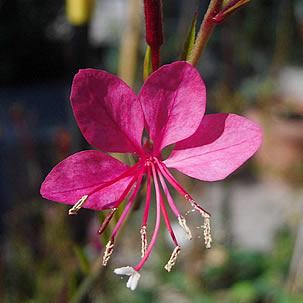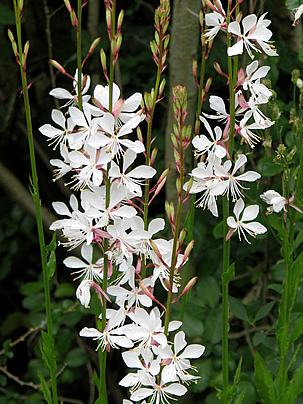The Beeblossom (Gaura lindheimeri) is a herbaceous, rhizomatous, and highly floriferous plant native to the states of Louisiana and Texas in the United States. It forms clumps of sparse and rounded branches, ranging from 20 to 60 inches (50 to 150 cm) in height, with a diameter of about 40 inches (100 cm). The stems are erect, wire-thin, branched, hairy, and emerge from an underground rhizome. Its lanceolate leaves are simple, alternate, hairy, with serrated margins, ranging in color from green to slightly bluish in the typical species. It begins blooming in spring and remains in flower until mid-autumn. The inflorescences emerge above the foliage in erect racemes, with flowers opening from the base towards the apex.

Each flower has four petals, arranged oppositely, and long stamens, giving the ensemble a curious butterfly-like appearance. There are many cultivars of Beeblossom, featuring plants of different sizes, more or less floriferous, with variegated or bronzed leaves, and flowers ranging from pure white to very dark and closed pink. Some varieties even start with white flowers in the morning, turning pink in the evening. Cultivars include ‘Whirling Butterflies,’ ‘Cherry Brandy,’ ‘Siskiyou Pink,’ ‘Pretty in Pink,’ ‘Corrie’s Gold,’ ‘Passionate Rainbow,’ and ‘Pink Cloud.’
Use Beeblossom in pots and flower beds, as well as in borders, masses, and combinations with other species. Its open, informal, and delicate texture, along with the profusion of flowers, make it an interesting choice for English, cottage, contemporary, and rocky gardens, and even in classic French and Italian gardens as a companion to roses in defined flower beds. It has the power to soften hard lines and imparts a simultaneously romantic and rustic atmosphere to the garden.
Additionally, Beeblossom requires minimal maintenance, limited to fertilization and two annual prunings. A lighter one in midsummer to stimulate densification and renew flowering, and a more intense one at the end of winter for cleaning and rejuvenation. Care should be taken not to prune Beeblossom drastically, as it may lead to branch death – ideally, prune it halfway.
It should preferably be grown in full sun, in well-drained soil enriched with organic matter and irrigated regularly. Once established, Beeblossom can tolerate drought. Despite preferring sun, it can be grown in partial shade, resulting in slightly fewer flowers. The Beeblossom thrives in subtropical and tropical high-altitude climates. It dislikes excess moisture, especially in winter, making it susceptible to fungal diseases. In temperate climates subject to intense cold and snow, Beeblossom is used as an annual. It multiplies in spring, either by seeds or by dividing clumps. During seedling growth, perform pinching (pruning of apical buds) to encourage branching and obtain a denser plant.


